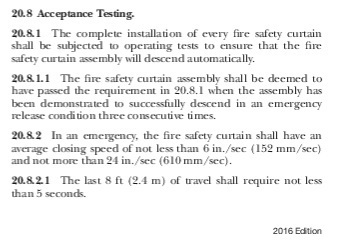Jay Ashworth
Well-Known Member
[ Here's another example of why people don't always want to be identified on postings; it might deprive the forum of the chance to improve overall safety if people won't ask questions for fear of incurring liability. ]
We did the regular test of our drop fire curtain at one of my houses this week. The manual trip engaged immediately, and the curtain, as expected, took about 5 seconds to drop from trim height to, say, 7 or 8 feet from the deck, where it hit the dash pot.
I expected, then, another 10-20 seconds to the deck, but it seemed more like 45-60.
What's the expected (or AHJ required) fall time for the rest of the travel?
We did the regular test of our drop fire curtain at one of my houses this week. The manual trip engaged immediately, and the curtain, as expected, took about 5 seconds to drop from trim height to, say, 7 or 8 feet from the deck, where it hit the dash pot.
I expected, then, another 10-20 seconds to the deck, but it seemed more like 45-60.
What's the expected (or AHJ required) fall time for the rest of the travel?



